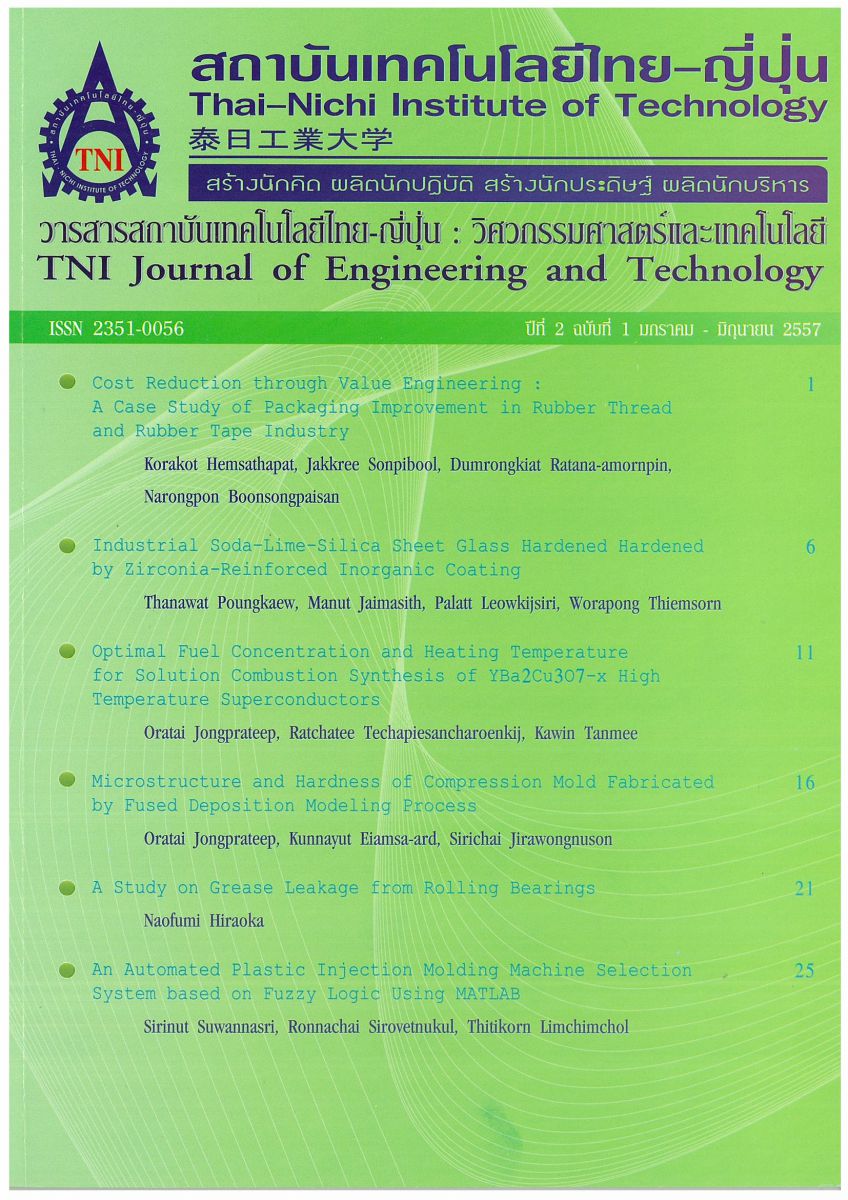An Automated Plastic Injection Molding Machine Selection System based on Fuzzy Logic Using MATLAB
Main Article Content
Abstract
In the phase of production planning, machine selection play important role in planning. At present, the majority of the machine selection process of plastic injection molding industry is conducted manually by an experienced planner. Therefore, the production plan depends on the skills and the experiences of the planner. However if a plan is conducted by an inexperienced planner it could lead to an uneconomical plan and delivery failure. Therefore, this study aims to develop a decision support tool for the plastic injection machine selection for the flexible production planning in dynamic planning and to enhance the irregular of operation flow by human’s decision making. The machine selection system is developed by using six selection criteria from a plastic manufacturer's case study to construct a system based on fuzzy logic theory using MATLAB. The proposed system is designed to reduce decision making time and maintain similar results for both experienced and inexperienced planners.
Article Details
Article Accepting Policy
The editorial board of Thai-Nichi Institute of Technology is pleased to receive articles from lecturers and experts in the fields of engineering and technology written in Thai or English. The academic work submitted for publication must not be published in any other publication before and must not be under consideration of other journal submissions. Therefore, those interested in participating in the dissemination of work and knowledge can submit their article to the editorial board for further submission to the screening committee to consider publishing in the journal. The articles that can be published include solely research articles. Interested persons can prepare their articles by reviewing recommendations for article authors.
Copyright infringement is solely the responsibility of the author(s) of the article. Articles that have been published must be screened and reviewed for quality from qualified experts approved by the editorial board.
The text that appears within each article published in this research journal is a personal opinion of each author, nothing related to Thai-Nichi Institute of Technology, and other faculty members in the institution in any way. Responsibilities and accuracy for the content of each article are owned by each author. If there is any mistake, each author will be responsible for his/her own article(s).
The editorial board reserves the right not to bring any content, views or comments of articles in the Journal of Thai-Nichi Institute of Technology to publish before receiving permission from the authorized author(s) in writing. The published work is the copyright of the Journal of Thai-Nichi Institute of Technology.
References
I. T. Tanev, T. Uozumi, and Y. Morotome, “Hybrid evolutionary algorithm-based real-world flexible job shop scheduling problem: An application service provider approach,” Applied Soft Computing, vol. 6, pp. 87-100, Mar. 2004.
N. Nagarur, P. Vrat, and W. Duongsuwan, “Production planning and scheduling for injection moulding of pipe fittings: A case study,” Int. J. Production Economics, vol. 53, pp. 157–170, May. 1997.
J. Huang, G. A. Süer, and S. B. R. Urs, “Genetic algorithm for rotary machine scheduling with dependent processing times,” Journal of Intelligence Manufacturing, 2011.
D. Cao, M. Chen, and G. Wan, “Parallel machine selection and job scheduling to minimize machine cost and job tardiness,” Computer & Operations Research, vol. 32, pp. 1995–2012, 2005.
J. Yen, R. Langari, and L.A. Zadeh, Industrial application of fuzzy logic and intelligent systems, New York, USA, 1994.
M. Negnevitsky, Artificial intelligence: a guide to intelligent systems, 2nd ed., England: Pearson Education Limited, 2005.
A. S. Hanna, and W. B. Lotfallah, “A fuzzy logic approach to the selection of cranes,” Automation in Construction, vol. 8, pp. 597–608, Mar. 1999.
H. Chujo, H. Oka, Y. Ikkai, and N. Komoda, “A real-time production scheduling method using attractor selection,” Computational Intelligence for Modelling Control and Automation, International Conference on Intelligent Agents, Web Technologies and Internet Commerce, vol. 1, pp. 511, 2005.


